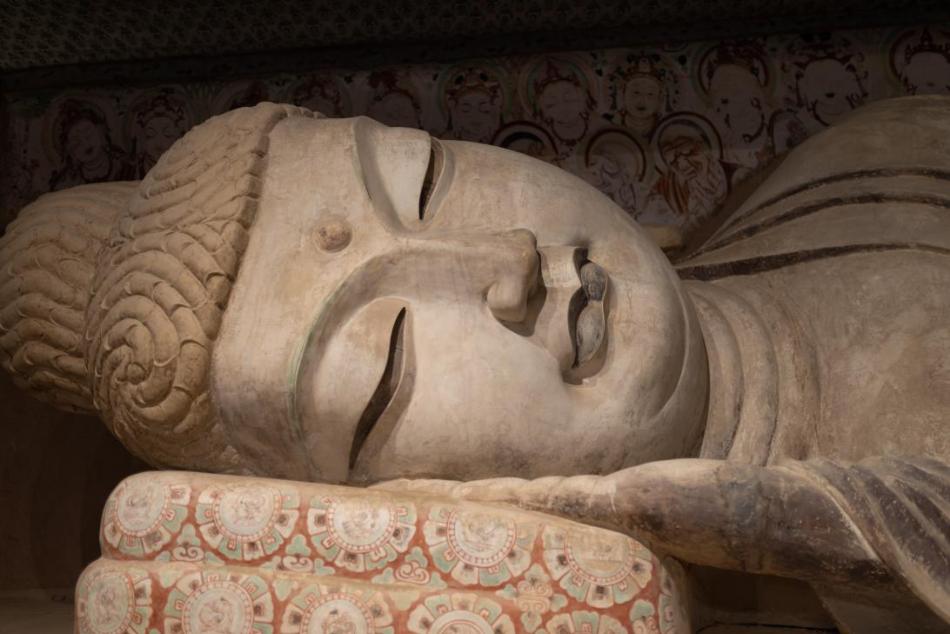As the most significant place on the ancient Silk Road, Dunhuang became a place for the convergence, collision, and integration of ancient Chinese and other cultures. Dunhuang grottoes, especially the Mogao Grottoes, are of significant scale and well-preserved, with a long history, rich content, and fine art, endowing them with precious historical, artistic, and scientific value.
To provide students in Wuhan University with an opportunity to have a close look at the archaeological achievements of Dunhuang grottoes, Wuhan University and Dunhuang Academy jointly hosted a special exhibition of the Dunhuang Grottoes, letting us feel the charm of Dunhuang culture. There are nearly 100 cultural relics on display, including more than 30 precious cultural relics, most of which left the Mogao Grottoes for the first time. The exhibition also contains representative murals, colored sculptures, and replicas of caves, exhibiting a total of 168 pieces/set, showing the rich archaeological achievements and great academic value of the Dunhuang grottoes in a comprehensive way.

The introduction at the entrance
As one enters the exhibition hall, the most eye-catching view is a replica of the Reclining Buddha statue in Cave 158 of the Mogao Grottoes, the largest reclining Buddha statue in the Dunhuang Grottoes. It is commonly known that in the Buddhist Record of the Western World, after Sakyamuni collected the last disciple in Kushinagar, he fell into silence and lay down in the north between two trees. To console people about the Buddha’s seeming passing, Sakyamuni lay on the lion’s bed on his right flank with a quiet expression and eyes slightly opened as if taking a nap, interpreting a sense of serenity and wisdom. As the image of Sakyamuni nirvana, it is the transmutation of eternal life from death, and Sakyamuni was the only one who achieved this eternal state.

The reclining Buddha statue
A selection of cultural relics is exhibited on the second floor, including replica models of representative grottoes, ancient vessels and scriptures, and pristine colored sculptures. The replica of cave 285 perfectly copied the earliest dated cave in the Mogao Grottoes, which is of great significance for the study of history and art. Cave 285 is rich in content and exquisite in art. The large niche is in the center of the cave, where the sitting Buddha is dressed in commendatory clothes and a broad belt-style shoulder cassock. Two small niches are carved on both sides, with a statue of the Zen Buddha in patchwork clothes inside. Outside of the niche are paintings of heaven, Bodhisattva, and other realms. The lateral wall of the cave is painted with a picture of the seven Buddhas, which is the earliest image of the seven Buddhas in Dunhuang Grottoes.

The replica cave

Cultural relics
Besides the magnificent sculptures and murals, what can also be witnessed is the effort of Dunhuang researchers and professionals. Because of the deep relationship between Wuhan University and Dunhuang, advanced techniques such as 3D laser scanning from the university have been used.
However, for decades technological conditions had not been ideal, and many researchers devoted their whole life to the Mogao Grottoes. In the exhibition, one section is specially used to display these hard-working researchers. For example, Chang Shuhong, one researcher introduced on the board, founded the research center in a weary environment. He drafted plans for replicating murals, numbered the discovered relics, and issued many high-quality academic articles. More and more researchers like him came to Dunhuang, sweated in the wind and sand, and grew alongside it. This special section impresses every visitor and helps people gain a general picture of the history.

Investigative records in Dunhuang Academy
“Once upon a time, I wondered why the Buddha statues in the Mogao Grottoes could not be repaired and restored to their original appearance. Later, I understood that those incompletely painted and broken bodies left traces of history,” Yang Weizhen, a student from the College of Chinese Language and Literature stated, “it is this kind of incompleteness that makes the Mogao Grottoes become more precious and brilliant.”
Photo by Lin Yangjie
Edited by Li Jing, Chen Jiaqi, Sylvia, Xi Bingqing